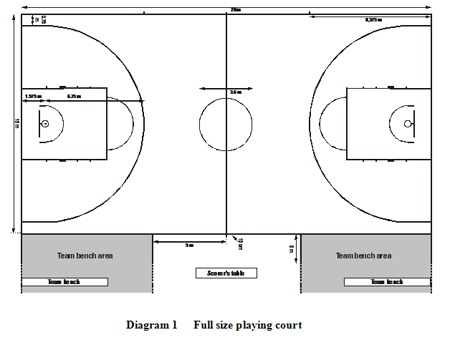|
New FIBA rules for basketball - 2010
|
The changes take effect on 1 October 2010 and will be incorporated in all FIBA international events that start after this date.
As a consequence of moving back the three-point line by 50 cm (20 inches) and modifications to the restricted areas which may require modification work.
FIBA have granted a delay of 2 years for full implementation.
All national Federations and FIBA zonal representatives have until 1 October 2012 to implement all the changes for higher level competitions.
English version of the new FIBA rules - 2010
Version Française des novellas règles FIBA - 2010
New FIBA rules and court marking for 2010
For high level competitions/Level 1 (main FIBA official competitions: i.e. Olympic Tournaments, World Championships for Men and Women, U19 and U17 World Championships for Men and Women and Zone/Continental Championships for Men and Women): as of 1st October 2010,i.e. after the 2010 FIBA World Championship.
For medium level competitions/Level 2 (i.e. all other FIBA official competitions and the high level competitions of the national federations): as of 1st October 2012, i.e. after the London 2012 Olympic Games.
The restricted areas shall be the floor rectangle areas marked on the playing court.
The restricted (three-second) area shall be a rectangle (not anymore a trapezoid) as per Diagram 1 below.
Three-point field goal area
The distance of the three-point line shall be 6,75m (and not 6,25m as present).
The two (2) small lines shall be marked outside the court, on the opposite side of the scorer's table and the team bench areas, with the outer edge at the distance of 8,325 m from the inside edge of the end lines; in other words, level to the top of the three-point line.
During the last two (2) minutes of the game and of the extra period, following the time-out granted to the team that has been entitled to the possession of the ball from its backcourt, the subsequent throw-in will be taken on the opposite side of the scorer's table from the "throw-in side line" and not as presently from the centre line extended.
The no-charge semicircles shall be marked on the playing court, under the baskets. The distance of the inner edge of the semicircles shall be 1,25 m from the centre of the basket (on the floor).
A charging (offensive) foul should never be called if the contact by the offensive player is with the defensive player standing within the no-charge semicircle.
If the throw-in is to be administered in the backcourt, if required by the respective rules, the 24-second device shall be reset to 24 seconds.
If the throw-in is to be administered in the frontcourt, if required by the respective rules, the 24-second device shall be reset as follows:
If 14 seconds or more are displayed on the 24-second device at the time the game was stopped, the 24-second device shall not be reset and shall remain the same.
If 13 seconds or less are displayed on the 24-second device at the time the game was stopped, the 24-second device shall be reset to 14 seconds.

Return to the top of new FIBA rules 2010
Règles officielles du basketball 2010
Cinq changements de nature plus importante prendront effet avec une portée limitée en 2010 et 2012.
À compter de 2010, elles s’appliqueront aux «compétitions majeures de la FIBA» tellesque décrites à l’article E.1.1 des règlements internes de la FIBA disponibles sur le site Web de la FIBA.
À compter de 2012 «au plus tard», elles s’appliqueront également à toutes les competitions officielles de la FIBA ainsi «qu’au plus haut niveau des fédérations nationales».
Afin de mieux visualiser les changements, SVP vous référer aux diagrammes
Ligne de lancers francs et zone restreinte
La zone restreinte sera délimitée par la surface du rectangle tracé sur l’aire de jeu.
Remarques : La zone restreinte (trois secondes) sera celle du rectangle et non plus celle du trapèze).
Les deux (2) petites lignes seront tracées à l’extérieur de l’aire de jeu sur le côté opposé de la table de marque et des zones des bancs des joueurs; ces lignes seront tracées de façonà ce que le bord éloigné soit à 8,235 m du bord interne des lignes de fond, soit end’autres mots, au même niveau que le point le plus éloigné de la ligne de trois points.
Au cours des deux (2) dernières minutes du temps réglementaire ou d’une prolongation et à la suite d’un temps d’arrêt à l’équipe ayant droit à la remise en jeu dans sa zone arrière,la remise en jeu subséquente se fera à l’opposé de la table de marque à la ligne de remise en jeu et non à l’extension de la ligne centrale comme c’est le cas présentement.
Le demi-cercle ‘pas d’assaut’ sera tracé sur le plancher en-dessous des paniers. La distance du bord intérieur du demi-cercle sera de 1,25 m du point central du panier (distancemesurée au sol).
Une faute offensive pour assaut ne devrait jamais être signalée lorsque le contact causé par le joueur offensif sur le joueur défensif survient lorsque ce dernier est debout à l’intérieur du demi-cercle ‘pas d’assaut’.
Lorsque la remise en jeu doit être effectuée en zone arrière en vertu d’une règle spécifique, le chronomètre de 24 secondes devra être replacé à 24 secondes.
Lorsque la remise en jeu doit être effectuée en zone avant en vertu d’une règle spécifique, le chronomètre de 24 secondes sera replacé selon les conditions suivantes :
Si le chronomètre affiche 14 secondes ou plus au moment de l’arrêt, le chronomètre ne sera pas replacé et affichera le même temps.
Si le chronomètre affiche 13 secondes ou moins au moment de l’arrêt. Le chronomètre sera replacé de façon à afficher 14 secondes.

Return to the top of new FIBA rules 2010
Return from new FIBA rules 2008 to women playing basketball blog page
Return from new FIBA rules 2010 to FIBA Index Page
new Fiba rules credits:
FIBA
Date Created: 09 December 2009
